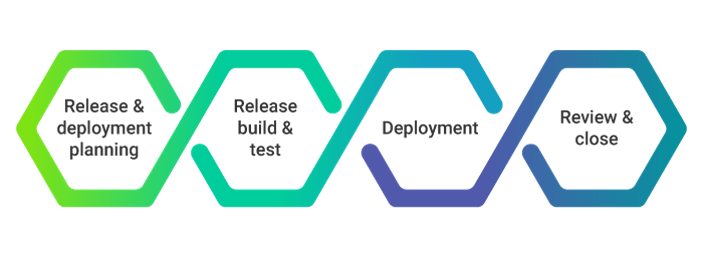
The main objective of the release and deployment management is planning, scheduling, and controlling of the build, testing, and deployment of releases and delivering the new functionality which is required by the businesses and at the same time, protecting the integrity of the services. Let’s understand the various aspects like principles, scope, values, and objectives of release and deployment management.
What is a Release in Release and Deployment Management?
A release is a set of changes that are authorized for implementation into an IT service. The different types of releases are:
- Major releases: It is a type of release which contains new hardware or software
- Minor releases: It is a type of release which makes significant improvements to the existing functions.
- Emergency releases: It is a type of release which is a quick fix to an emergency problem
Objectives of Release and Deployment Management
The objectives of release and deployment management are:
- To define and agree to the plans made for release and deployment management.
- Create and test the release packages, store them in a definitive media library (DML), and record them in the CMS.
- To deploy the release packages as per the agreed plan from the definitive media library.
- Make sure that the organization and the stakeholder involved are effectively managed.
- To ensure that the services which are new and changed can deliver the agreed-upon utility and warranty.
- Make sure that there is an adequate transfer of knowledge to the users, customers, and the IT department.
Scope of Release And Deployment Management
The scope of release and deployment management includes all the different configuration items which are needed to implement a release. It includes the following:
- Physical and virtual assets
- Training for the users and staff
- Software and applications
- Related contracts and agreements
Testing and authorizing changes do not come under the scope of release and deployment, but it should ensure that the activities are being carried out.
Value of Release and Deployment Management
Release and deployment management allows the service provider to add value to his business by doing the following:
- Delivering change at a quicker pace and at an optimum cost with minimum risks involved.
- Giving assurance to the customers and users that they can make use of the changed service in a way that can support their business goals.
- Making contributions to meet the necessary auditable requirements for traceability.
- When the release and deployment management is properly implemented, it will make a significant difference to the service costs of an organization.
Principles and Basic Concepts of Release and Deployment Management
- Release Policy: Proper policies for release and deployment should be in place to achieve a proper balance between service stability, cost, and agility.
- Release Identification: All the releases should be identified uniquely with an identification that includes a version number as per the scheme described in the release.
- Release Unit: A release unit consists of the components of an IT service which are usually released together and include enough components to perform a useful function.
- The Release Package: It describes the one or more release units that are being built, tested, and deployed together as one release.
- Release Deployment: Deployments can be made in such a way that all the components or released at once or released phase by phase. The release and deployment mechanisms can be manual or automated.
Process Activities of Release and Deployment Management
The 4 phases of release and deployment management which begin with planning and end with deployment and review are:
1. Release and Deployment Planning
- The main aim of a release and deployment plan is to clearly illustrate a set of guidelines regarding what should be included in a release and how it will be deployed into production.
- The plan is approved as a part of the change management process.
- Change management authorizes the planning process to start for a release at the beginning of the release deployment and planning stage.
- The plan aims to address the following topics:
- The changes that will be included in the release
- The parties who will be affected by the release
- The risks may occur as a result of the introduction of the release.
- The suitable audience for the release
- A proper chain of approval makes it clear regarding which of the stakeholders involved can authorize changes at each stage of the release.
- Outlining the ownership of the team which is responsible for the release.
- The strategy and schedule for deployment of the release.
2. Release build and test
- After the change management approves the plan and it has been readied, the teams which are responsible for the plans need to build and test the release. This includes the documentation, software, and other elements of the release plan.
- Documentation is created at the beginning of the process to make sure that the developers can build the release package with efficiency and great effectiveness.
- Accurate records are kept throughout the build process to ensure that the process can be repeated if necessary.
- Organizations follow standardized procedures which stringently follow guidelines to build a complete release package.
- The release is tested throughout the process in all aspects until they are deployed live.
3. Deployment
- This is the phase in which the release package is deployed into the live environment.
- It is essential to plan and prepare adequately before deploying a release.
- As part of the preparation, it is important to make sure that the potential risks are identified and mitigated, the order of release should be specified, and it should be confirmed if the target group is ready for the deployment or not.
- Deployment starts when the release package is authorized by the change management to be deployed into the required target environment.
- It ends when the release is handed over to service operations and early life support.
4. Review and Close
- After the deployment of a release, it is important to review the entire process and learn from it.
- Feedback is obtained from the process, and the performance is compared to the benchmark, with the results being reviewed and discussed by the parties involved.
- The reviews should be carefully made to check if all the necessary requirements for quality and performance have been met.
- The review also checks if the transfer of knowledge was complete, if there were any errors, changes made and if they have been documented properly.
- A deployment is considered to be closed only after the support has been formally handed over to operations.
Challenges of Release and Deployment Management
The challenges involved in release and deployment are:
- Developing standard measures for performance and measurement for the different projects and suppliers.
- Dealing with the projects and suppliers where there are inaccuracies in the estimated delivery dates and ever-present delays in scheduling.
- Understanding the perspectives of the different stakeholders.
- Building a culture where there are a thorough understanding and management of risks.
Risks of Release and Deployment Management
The risks involved in release and deployment management are:
- Usage of staff who are not dedicated to releasing and deployment management.
- Inadequately defined scope and understanding of deficiencies.
- Inability to use the release and deployment management for service retirement.
- Financial shortage
- Changes in the organization can have an effect on employee morale.
- Failure of the suppliers to meet the obligations as per the contract.
Conclusion
Release and Deployment management thereby defines and agrees to the plans made for release and deployment management, and creates the test the release packages. It deploys the release packages as per the agreed plan from the definitive media library and ensures that the organization and the stakeholder involved are effectively managed. Learn about more such processes and methods to optimize effective service management in your organization with ITIL 4 Foundation certification training, and take your career to the next level.
Know more about Service Management best practices through Invensis Learning’s IT Service Management certification training on ITIL 4 Foundation Certification, SIAM Foundation, SIAM professional, VeriSM, etc.
















